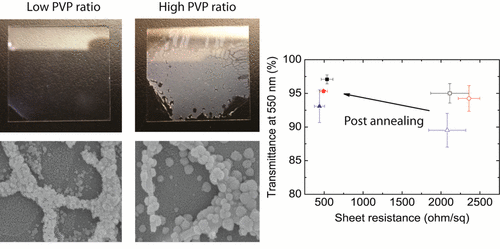当前位置:
X-MOL 学术
›
ACS Appl. Mater. Interfaces
›
论文详情
Our official English website, www.x-mol.net, welcomes your feedback! (Note: you will need to create a separate account there.)
Toward High Conductivity of Electrospun Indium Tin Oxide Nanofibers with Fiber Morphology Dependent Surface Coverage: Postannealing and Polymer Ratio Effects
ACS Applied Materials & Interfaces ( IF 9.5 ) Pub Date : 2017-09-19 00:00:00 , DOI: 10.1021/acsami.7b08987 Sangcheol Yoon , Hyebin Kim , Eun-Sol Shin 1 , Jun Nyeong Huh , Yong-Young Noh 1 , Byoungchoo Park , Inchan Hwang
ACS Applied Materials & Interfaces ( IF 9.5 ) Pub Date : 2017-09-19 00:00:00 , DOI: 10.1021/acsami.7b08987 Sangcheol Yoon , Hyebin Kim , Eun-Sol Shin 1 , Jun Nyeong Huh , Yong-Young Noh 1 , Byoungchoo Park , Inchan Hwang
Affiliation

|
High electrical conductivity of metal oxide thin films needs uniform surface coverage, which has been the issue for the thin films based on electrospun nanofibers (NFs) that have advantage over the sputtered/spin-coated films with respect to large surface area and mechanical flexibility. Herein, we investigated a reduction in the sheet resistance of electrospun indium tin oxide (ITO) NF films with improved surface coverage. We found that the surface coverage depends significantly on the electrospinnable polymer concentration in the precursor solutions, especially after post-hot-plate annealing following the infrared radiation furnace treatment. The postannealing process increases crystallinity and oxygen vacancies. However, with a higher PVP content, it makes the surface of ITO NFs more prominently rough as a result of the formation of larger sphere-shaped ITO particles on the NF surface, which gives rise to poor surface coverage. A less poly(vinylpyrrolidone) (PVP) content in ITO NF films by electrospinning for short deposition times was found to improve surface coverage even after postannealing. The sheet resistance notably decreases, down to as low as 350 Ω/sq, with a high transmittance of over 90%. Our study provides an understanding on how to achieve high electrical conductivity of ITO NF films with high surface coverage, which can be utilized for the optoelectronic and sensing applications.
中文翻译:

依赖于纤维形态的表面覆盖率实现电纺氧化铟锡纳米纤维的高电导率:后退火和聚合物比率效应
金属氧化物薄膜的高电导率需要均匀的表面覆盖率,这已成为基于静电纺丝纳米纤维(NFs)的薄膜的问题,该薄膜在大表面积和机械柔韧性方面优于溅射/旋涂膜。在本文中,我们研究了电纺铟锡氧化物(ITO)NF薄膜具有改善的表面覆盖率的薄层电阻的降低。我们发现表面覆盖率显着取决于前体溶液中可电纺聚合物的浓度,尤其是在红外辐射炉处理后的热板后退火之后。后退火过程增加了结晶度和氧空位。但是,随着PVP含量的增加,由于在NF表面上形成了较大的球形ITO颗粒,ITO NFs的表面变得更加明显粗糙,这导致较差的表面覆盖率。发现通过电纺短时间沉积在ITO NF膜中较少的聚乙烯吡咯烷酮(PVP)含量,即使在退火后也能改善表面覆盖率。薄层电阻显着降低,低至350Ω/ sq,透射率超过90%。我们的研究提供了有关如何实现具有高表面覆盖率的ITO NF薄膜的高电导率的理解,可将其用于光电和传感应用。发现通过电纺短时间沉积在ITO NF膜中较少的聚乙烯吡咯烷酮(PVP)含量,即使在退火后也能改善表面覆盖率。薄层电阻显着降低,低至350Ω/ sq,透射率超过90%。我们的研究提供了有关如何实现具有高表面覆盖率的ITO NF薄膜的高电导率的理解,可将其用于光电和传感应用。发现通过电纺短时间沉积在ITO NF膜中较少的聚乙烯吡咯烷酮(PVP)含量,即使在退火后也能改善表面覆盖率。薄层电阻显着降低,低至350Ω/ sq,透射率超过90%。我们的研究提供了有关如何实现具有高表面覆盖率的ITO NF薄膜的高电导率的理解,可将其用于光电和传感应用。
更新日期:2017-09-20
中文翻译:

依赖于纤维形态的表面覆盖率实现电纺氧化铟锡纳米纤维的高电导率:后退火和聚合物比率效应
金属氧化物薄膜的高电导率需要均匀的表面覆盖率,这已成为基于静电纺丝纳米纤维(NFs)的薄膜的问题,该薄膜在大表面积和机械柔韧性方面优于溅射/旋涂膜。在本文中,我们研究了电纺铟锡氧化物(ITO)NF薄膜具有改善的表面覆盖率的薄层电阻的降低。我们发现表面覆盖率显着取决于前体溶液中可电纺聚合物的浓度,尤其是在红外辐射炉处理后的热板后退火之后。后退火过程增加了结晶度和氧空位。但是,随着PVP含量的增加,由于在NF表面上形成了较大的球形ITO颗粒,ITO NFs的表面变得更加明显粗糙,这导致较差的表面覆盖率。发现通过电纺短时间沉积在ITO NF膜中较少的聚乙烯吡咯烷酮(PVP)含量,即使在退火后也能改善表面覆盖率。薄层电阻显着降低,低至350Ω/ sq,透射率超过90%。我们的研究提供了有关如何实现具有高表面覆盖率的ITO NF薄膜的高电导率的理解,可将其用于光电和传感应用。发现通过电纺短时间沉积在ITO NF膜中较少的聚乙烯吡咯烷酮(PVP)含量,即使在退火后也能改善表面覆盖率。薄层电阻显着降低,低至350Ω/ sq,透射率超过90%。我们的研究提供了有关如何实现具有高表面覆盖率的ITO NF薄膜的高电导率的理解,可将其用于光电和传感应用。发现通过电纺短时间沉积在ITO NF膜中较少的聚乙烯吡咯烷酮(PVP)含量,即使在退火后也能改善表面覆盖率。薄层电阻显着降低,低至350Ω/ sq,透射率超过90%。我们的研究提供了有关如何实现具有高表面覆盖率的ITO NF薄膜的高电导率的理解,可将其用于光电和传感应用。



























 京公网安备 11010802027423号
京公网安备 11010802027423号